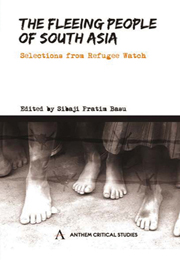Book contents
- Frontmatter
- Contents
- Acronyms and Abbreviations
- Foreword by Ranabir Samaddar
- Preface
- ETHICAL ISSUES
- LAWS
- SOUTH ASIA
- Introduction
- Refugees in South Asia: An Overview
- Internally Displaced Persons in Sri Lanka
- A Matter of Ethnicity
- Scrutinizing the Land Resettlement Scheme in Bhutan
- The Taliban Shelter Seekers or Refugee Warriors?
- Afghan Refugees head for Tajikistan, holed up in the Pamir Mountains
- Impact of International Jurisdiction on Afghan Refugee Rights
- Development Induced Displacement in Pakistan
- On the Trail of Burma's Internal Refugees
- Assault on Minorities in Bangladesh: An Analysis
- Neoliberal Globalization and Women's Experiences of Forced Migrations in Asia
- Who Went Where and How are They Doing? Pakistanis and Indians Outside South Asia
- INDIA
- GENDER
- INTERVIEW/CORRESPONDENCE
- REPRESENTATIONS
- Index
A Matter of Ethnicity
from SOUTH ASIA
Published online by Cambridge University Press: 05 March 2012
- Frontmatter
- Contents
- Acronyms and Abbreviations
- Foreword by Ranabir Samaddar
- Preface
- ETHICAL ISSUES
- LAWS
- SOUTH ASIA
- Introduction
- Refugees in South Asia: An Overview
- Internally Displaced Persons in Sri Lanka
- A Matter of Ethnicity
- Scrutinizing the Land Resettlement Scheme in Bhutan
- The Taliban Shelter Seekers or Refugee Warriors?
- Afghan Refugees head for Tajikistan, holed up in the Pamir Mountains
- Impact of International Jurisdiction on Afghan Refugee Rights
- Development Induced Displacement in Pakistan
- On the Trail of Burma's Internal Refugees
- Assault on Minorities in Bangladesh: An Analysis
- Neoliberal Globalization and Women's Experiences of Forced Migrations in Asia
- Who Went Where and How are They Doing? Pakistanis and Indians Outside South Asia
- INDIA
- GENDER
- INTERVIEW/CORRESPONDENCE
- REPRESENTATIONS
- Index
Summary
DIFFERENCES?
Differences in culture, ethnicity and nationality are assets, as well as, hazards in a world becoming technically smaller every day. Most of the feuds and wars of the 1990s, all of them catastrophes to millions of people, resulted in cultural, ethnic or religious tensions.
Taking advantage of the situation in Bhutan, beginning from 1991, the propaganda machinery of the Royal Government of Bhutan has been disseminating information that the present crisis in the country is an ethnic conflict fought between the Buddhist Drukpas (supposedly the sons of the soil) and the Hindu Lhotshampas (alleged to be recent migrants). […] To understand the Bhutanese refugee problem, one needs to understand the ethnic background of the refugees and other groups of population in Bhutan.
The present refugee population in Nepal and a little in India consists of Lhotshampas who are people of Nepali origin; they had migrated to Bhutan from Nepal, through Sikkim and West Bengal, in the mid nineteenth and early twentieth centuries. They were settled in the southern districts of Samchi, Chukha, Chirang, Dagapela, Gaylegphug and Samdrupjonkhar.
Prior to this refugee crisis, foreigners seem not to have known that Bhutan had people of Nepali origin. The tourism booklets depicted Bhutan as the land of the Drukpas. The ruling Ngalungs who are concentrated in the north-west valleys of Haa, Paro and Thimphuinsist that the central Kheng people and eastern Bhutanese (Sharchops) also fall under the nomenclature of Drukpas, as has happened in Nepal, where there exist multiple communities under one nationality.
- Type
- Chapter
- Information
- The Fleeing People of South AsiaSelections from Refugee Watch, pp. 159 - 162Publisher: Anthem PressPrint publication year: 2009



